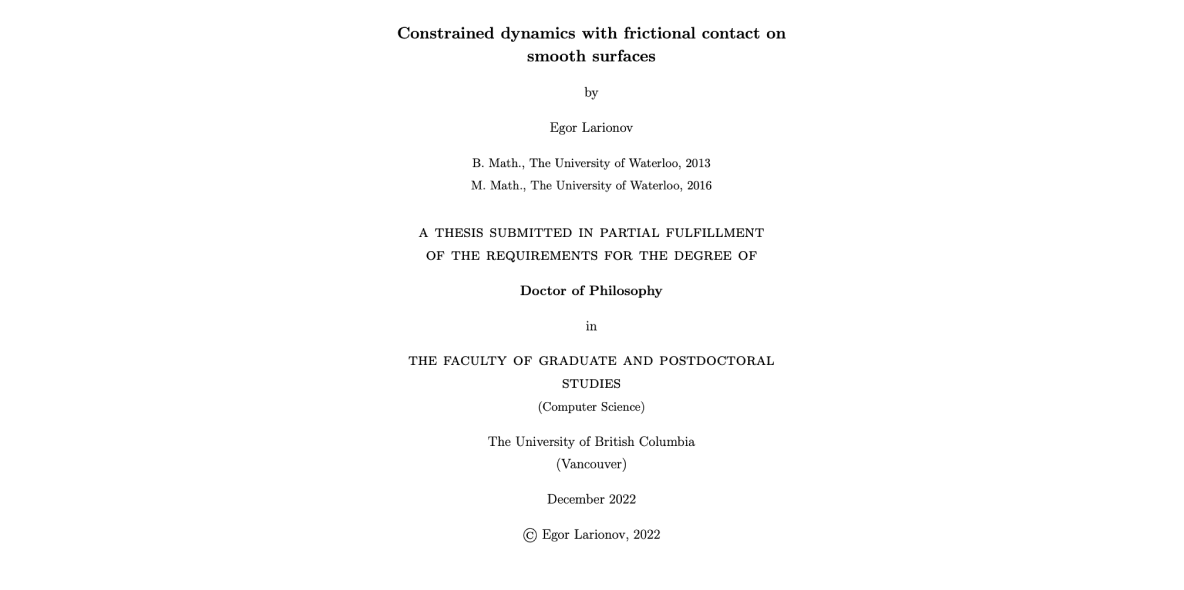
Egor Larionov
I am a researcher currently working at Meta Reality Labs.I am interested in physically-based animation, geometry processing and scientific computing. More about me.
Publications
-
Quaffure: Real-Time Quasi-Static Neural Hair Simulation ,
Tuur Stuyck, Gene Wei-Chin Lin, Egor Larionov, Hsiao-yu Chen, Aljaz Bozic, Nikolaos Sarafianos, Doug Roble,
IEEE/CVF Conference on Computer Vision and Pattern Recognition (CVPR) ,
-
PGC: Physics-Based Gaussian Cloth from a Single Pose,
Michelle Guo, Matt Jen-Yuan Chiang, Igor Santesteban, Nikolaos Sarafianos, Hsiao-yu Chen, Oshri Halimi, Aljaž Božič, Shunsuke Saito, Jiajun Wu, C. Karen Liu, Tuur Stuyck, Egor Larionov,
IEEE/CVF Conference on Computer Vision and Pattern Recognition (CVPR) ,
-
DiffAvatar: Simulation-Ready Garment Optimization with Differentiable Simulation,
Yifei Li, Hsiao-yu Chen, Egor Larionov, Nikolaos Sarafianos, Wojciech Matusik, Tuur Stuyck,
IEEE/CVF Conference on Computer Vision and Pattern Recognition (CVPR) ,
-
Estimating Cloth Elasticity Parameters From Homogenized Yarn-Level Models,
Joy Xiaoji Zhang, Gene Wei-Chin Lin, Lukas Bode, Hsiao-yu Chen, Tuur Stuyck, Egor Larionov,
ACM SIGGRAPH Conference on Motion, Interaction, and Games (MIG) ,
-
In situ measurement of friction on the human body,
Pearson A. Wyder-Hodge, Egor Larionov, Dinesh K. Pai,
Tribology International ,
-
Constrained dynamics with frictional contact on smooth surfaces,
Egor Larionov,
PhD Thesis (University of British Columbia) ,
-
Implicit Frictional Dynamics with Soft Constraints,
Egor Larionov, Andreas Longva, Uri M. Ascher, Jan Bender, Dinesh K. Pai,
IEEE Transactions on Visualization and Computer Graphics (TVCG) ,
-
In situ measurement of friction on curved surfaces,
Pearson A. Wyder-Hodge, Egor Larionov, Dinesh K. Pai,
Tribology International ,
-
Simulating deformable objects for computer animation: a numerical perspective,
Uri M. Ascher, Egor Larionov, Seung Heon Sheen, Dinesh K. Pai,
Journal of Computational Dynamics ,
-
Volume Preserving Simulation of Soft Tissue with Skin,
Seung Heon Sheen, Egor Larionov, Dinesh K. Pai,
Proceedings of the ACM on Computer Graphics and Interactive Techniques ,
-
Frictional Contact on Smooth Elastic Solids,
Egor Larionov, Ye Fan, Dinesh K. Pai,
ACM Transactions on Graphics ,
-
The Human Touch: Measuring Contact with Real Human Soft Tissues,
Dinesh K. Pai, Austin Rothwell, Pearson Wyder-Hodge, Alistair Wick, Ye Fan, Egor Larionov, Darcy Harrison, Debanga R. Neog, Cole Shing,
ACM Transactions on Graphics (SIGGRAPH) ,
-
Variational Stokes: A Unified Pressure-Viscosity Solver for Accurate Viscous Liquids,
Egor Larionov*, Christopher Batty*, Robert Bridson, (*Joint first authors)
ACM Transactions on Graphics (SIGGRAPH) ,
-














